Review: Work-Life Balance Impact on Employee Performance (COM10009)
VerifiedAdded on 2023/06/03
|14
|3043
|90
Report
AI Summary
This report examines the relationship between work-life balance and employee performance, drawing on four articles that explore various aspects of this connection. The introduction defines work-life balance and highlights its significance in the context of increasing workplace demands and employee well-being. The discussion section provides an in-depth analysis of the selected articles, including a study on flexible human resource management and employee engagement, an investigation of work-family conflict in Sri Lanka, an exploration of motherhood and employment in Sri Lanka, and an examination of the work-life balance in the telecommunication industry of Sri Lanka. The conclusion synthesizes the findings, emphasizing the positive impact of work-life balance on employee satisfaction and performance. The report recommends that companies provide facilities for parents and create a work environment that supports a healthy balance between work and personal life. The report underscores the importance of flexible policies and supervisory styles in fostering employee satisfaction and reducing work-related conflicts. The studies reviewed provide strong evidence of the positive impact of work-life balance on employee performance.
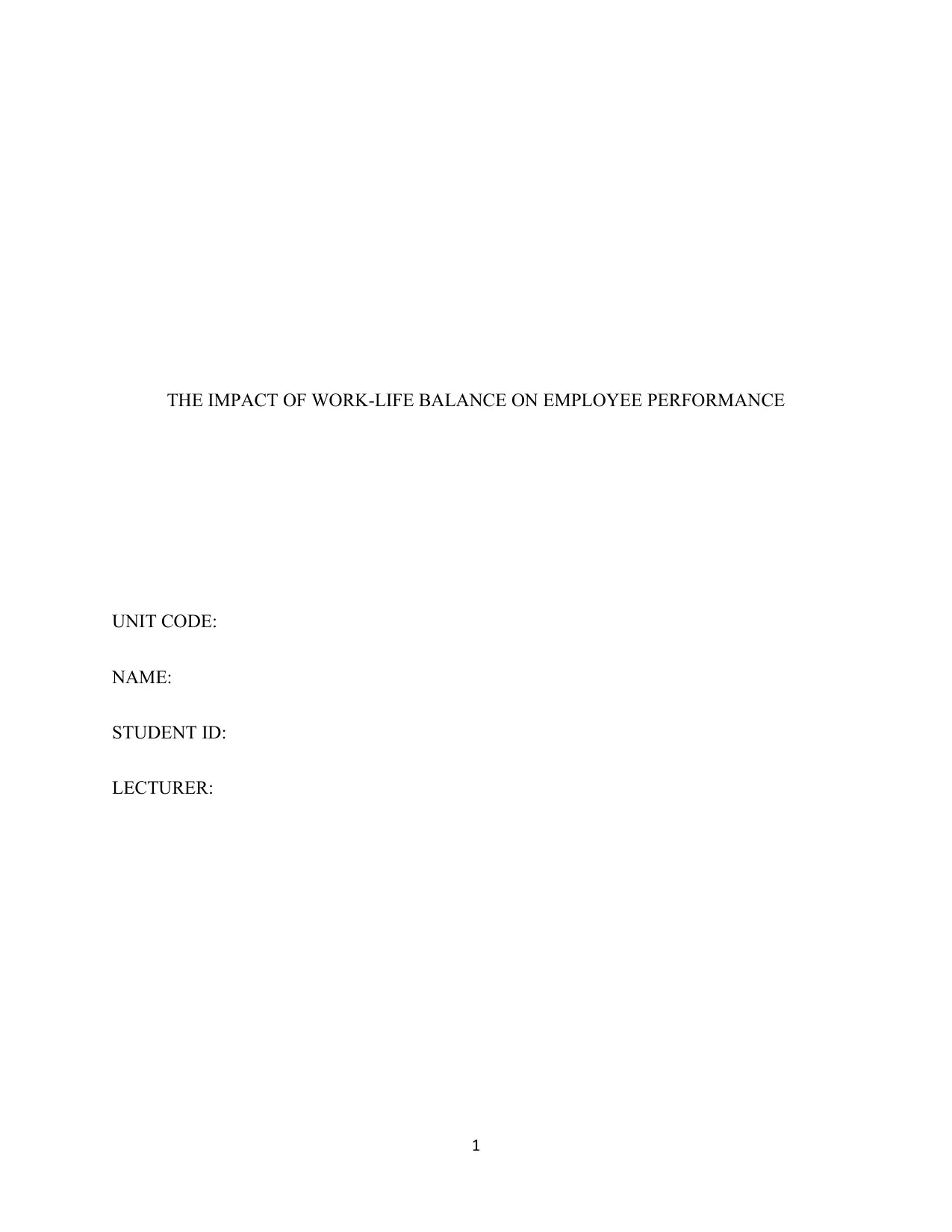
THE IMPACT OF WORK-LIFE BALANCE ON EMPLOYEE PERFORMANCE
UNIT CODE:
NAME:
STUDENT ID:
LECTURER:
1
UNIT CODE:
NAME:
STUDENT ID:
LECTURER:
1
Paraphrase This Document
Need a fresh take? Get an instant paraphrase of this document with our AI Paraphraser
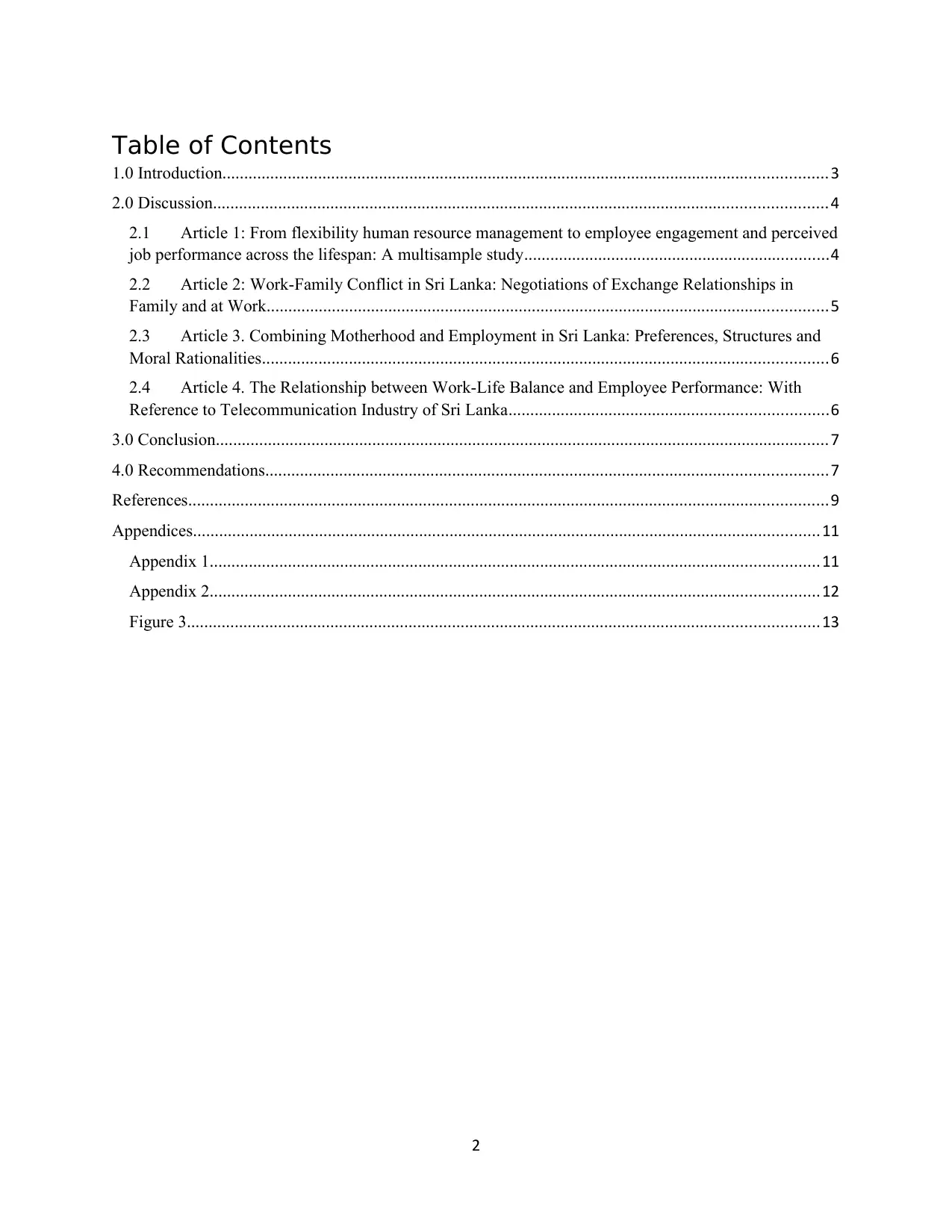
Table of Contents
1.0 Introduction...........................................................................................................................................3
2.0 Discussion.............................................................................................................................................4
2.1 Article 1: From flexibility human resource management to employee engagement and perceived
job performance across the lifespan: A multisample study......................................................................4
2.2 Article 2: Work-Family Conflict in Sri Lanka: Negotiations of Exchange Relationships in
Family and at Work.................................................................................................................................5
2.3 Article 3. Combining Motherhood and Employment in Sri Lanka: Preferences, Structures and
Moral Rationalities..................................................................................................................................6
2.4 Article 4. The Relationship between Work-Life Balance and Employee Performance: With
Reference to Telecommunication Industry of Sri Lanka.........................................................................6
3.0 Conclusion.............................................................................................................................................7
4.0 Recommendations.................................................................................................................................7
References...................................................................................................................................................9
Appendices................................................................................................................................................11
Appendix 1............................................................................................................................................11
Appendix 2............................................................................................................................................12
Figure 3.................................................................................................................................................13
2
1.0 Introduction...........................................................................................................................................3
2.0 Discussion.............................................................................................................................................4
2.1 Article 1: From flexibility human resource management to employee engagement and perceived
job performance across the lifespan: A multisample study......................................................................4
2.2 Article 2: Work-Family Conflict in Sri Lanka: Negotiations of Exchange Relationships in
Family and at Work.................................................................................................................................5
2.3 Article 3. Combining Motherhood and Employment in Sri Lanka: Preferences, Structures and
Moral Rationalities..................................................................................................................................6
2.4 Article 4. The Relationship between Work-Life Balance and Employee Performance: With
Reference to Telecommunication Industry of Sri Lanka.........................................................................6
3.0 Conclusion.............................................................................................................................................7
4.0 Recommendations.................................................................................................................................7
References...................................................................................................................................................9
Appendices................................................................................................................................................11
Appendix 1............................................................................................................................................11
Appendix 2............................................................................................................................................12
Figure 3.................................................................................................................................................13
2
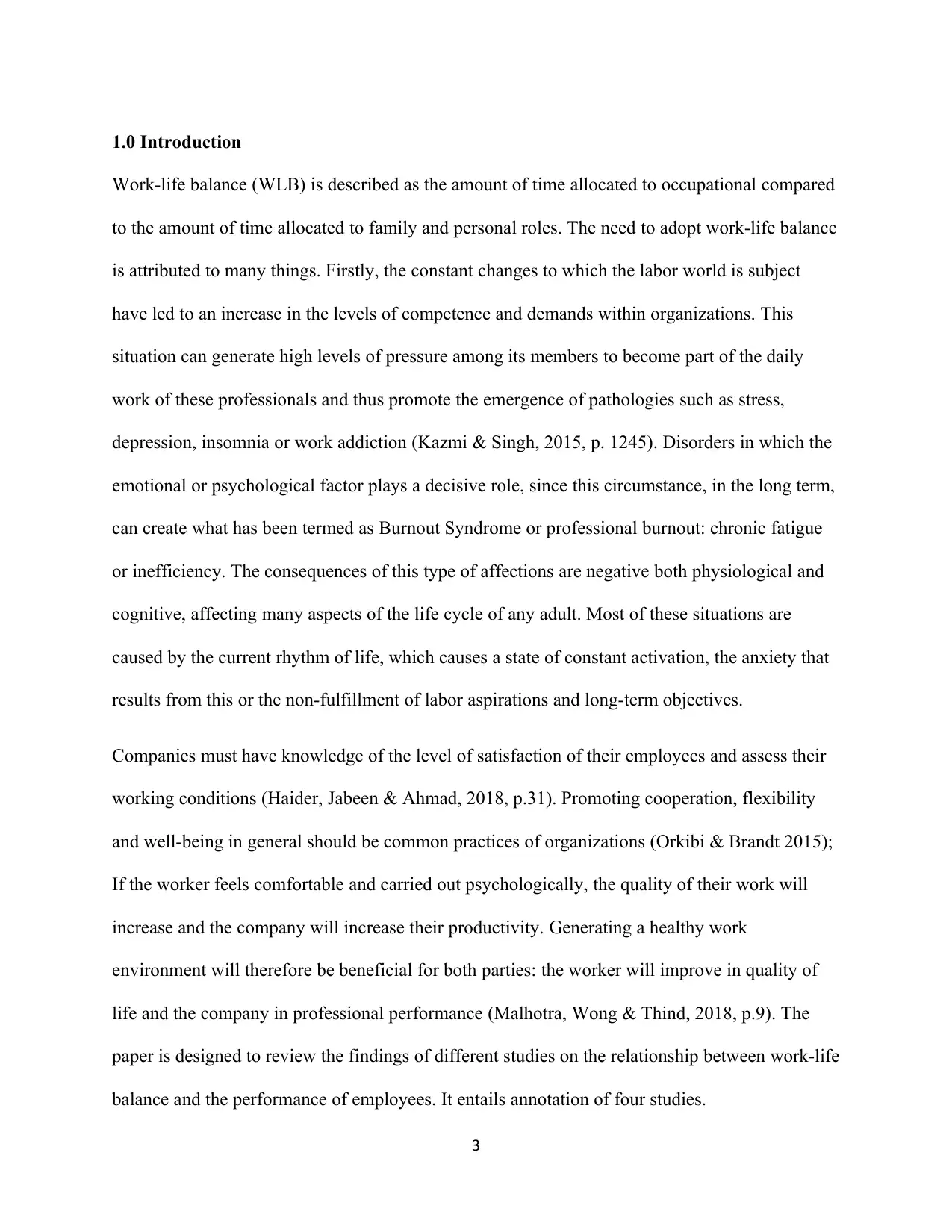
1.0 Introduction
Work-life balance (WLB) is described as the amount of time allocated to occupational compared
to the amount of time allocated to family and personal roles. The need to adopt work-life balance
is attributed to many things. Firstly, the constant changes to which the labor world is subject
have led to an increase in the levels of competence and demands within organizations. This
situation can generate high levels of pressure among its members to become part of the daily
work of these professionals and thus promote the emergence of pathologies such as stress,
depression, insomnia or work addiction (Kazmi & Singh, 2015, p. 1245). Disorders in which the
emotional or psychological factor plays a decisive role, since this circumstance, in the long term,
can create what has been termed as Burnout Syndrome or professional burnout: chronic fatigue
or inefficiency. The consequences of this type of affections are negative both physiological and
cognitive, affecting many aspects of the life cycle of any adult. Most of these situations are
caused by the current rhythm of life, which causes a state of constant activation, the anxiety that
results from this or the non-fulfillment of labor aspirations and long-term objectives.
Companies must have knowledge of the level of satisfaction of their employees and assess their
working conditions (Haider, Jabeen & Ahmad, 2018, p.31). Promoting cooperation, flexibility
and well-being in general should be common practices of organizations (Orkibi & Brandt 2015);
If the worker feels comfortable and carried out psychologically, the quality of their work will
increase and the company will increase their productivity. Generating a healthy work
environment will therefore be beneficial for both parties: the worker will improve in quality of
life and the company in professional performance (Malhotra, Wong & Thind, 2018, p.9). The
paper is designed to review the findings of different studies on the relationship between work-life
balance and the performance of employees. It entails annotation of four studies.
3
Work-life balance (WLB) is described as the amount of time allocated to occupational compared
to the amount of time allocated to family and personal roles. The need to adopt work-life balance
is attributed to many things. Firstly, the constant changes to which the labor world is subject
have led to an increase in the levels of competence and demands within organizations. This
situation can generate high levels of pressure among its members to become part of the daily
work of these professionals and thus promote the emergence of pathologies such as stress,
depression, insomnia or work addiction (Kazmi & Singh, 2015, p. 1245). Disorders in which the
emotional or psychological factor plays a decisive role, since this circumstance, in the long term,
can create what has been termed as Burnout Syndrome or professional burnout: chronic fatigue
or inefficiency. The consequences of this type of affections are negative both physiological and
cognitive, affecting many aspects of the life cycle of any adult. Most of these situations are
caused by the current rhythm of life, which causes a state of constant activation, the anxiety that
results from this or the non-fulfillment of labor aspirations and long-term objectives.
Companies must have knowledge of the level of satisfaction of their employees and assess their
working conditions (Haider, Jabeen & Ahmad, 2018, p.31). Promoting cooperation, flexibility
and well-being in general should be common practices of organizations (Orkibi & Brandt 2015);
If the worker feels comfortable and carried out psychologically, the quality of their work will
increase and the company will increase their productivity. Generating a healthy work
environment will therefore be beneficial for both parties: the worker will improve in quality of
life and the company in professional performance (Malhotra, Wong & Thind, 2018, p.9). The
paper is designed to review the findings of different studies on the relationship between work-life
balance and the performance of employees. It entails annotation of four studies.
3
⊘ This is a preview!⊘
Do you want full access?
Subscribe today to unlock all pages.

Trusted by 1+ million students worldwide
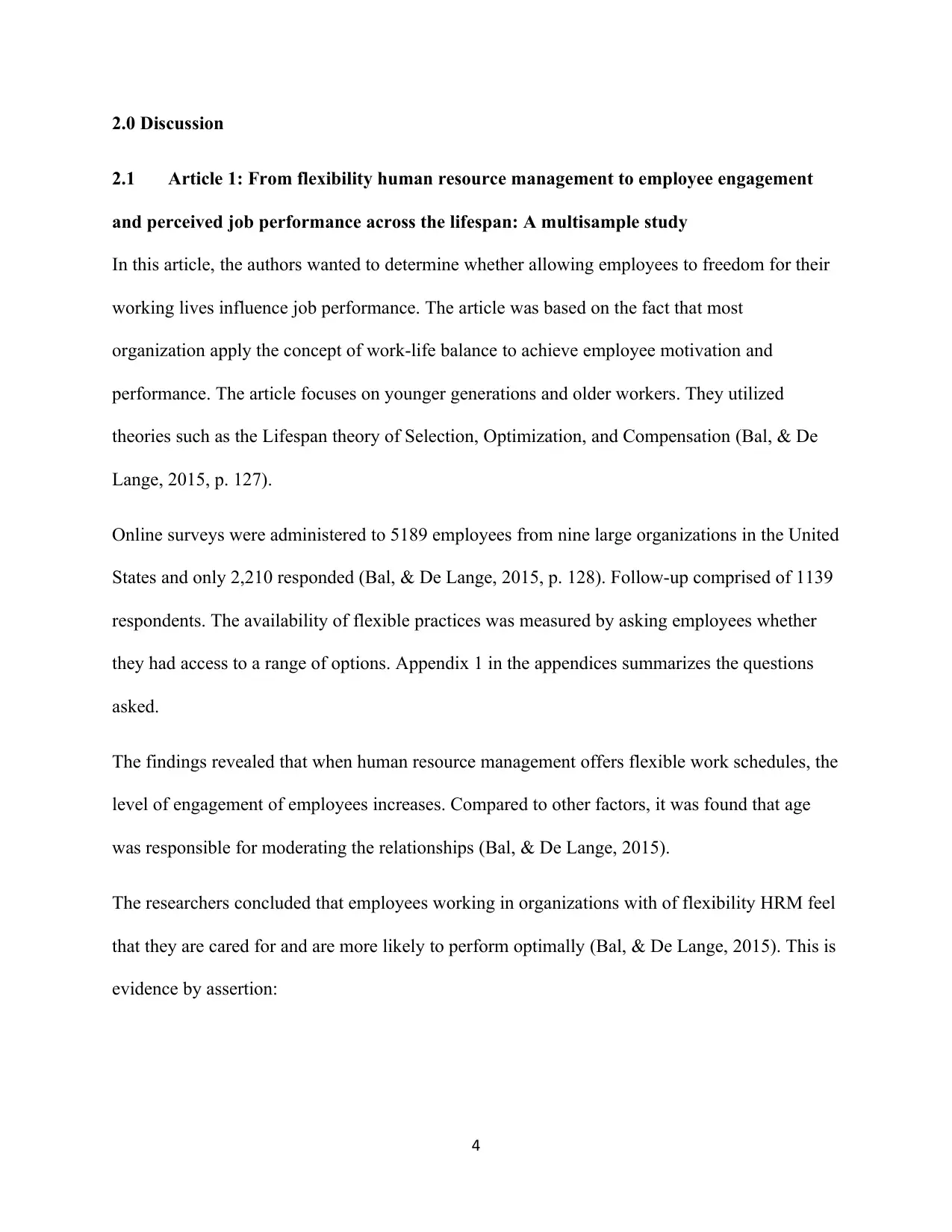
2.0 Discussion
2.1 Article 1: From flexibility human resource management to employee engagement
and perceived job performance across the lifespan: A multisample study
In this article, the authors wanted to determine whether allowing employees to freedom for their
working lives influence job performance. The article was based on the fact that most
organization apply the concept of work-life balance to achieve employee motivation and
performance. The article focuses on younger generations and older workers. They utilized
theories such as the Lifespan theory of Selection, Optimization, and Compensation (Bal, & De
Lange, 2015, p. 127).
Online surveys were administered to 5189 employees from nine large organizations in the United
States and only 2,210 responded (Bal, & De Lange, 2015, p. 128). Follow-up comprised of 1139
respondents. The availability of flexible practices was measured by asking employees whether
they had access to a range of options. Appendix 1 in the appendices summarizes the questions
asked.
The findings revealed that when human resource management offers flexible work schedules, the
level of engagement of employees increases. Compared to other factors, it was found that age
was responsible for moderating the relationships (Bal, & De Lange, 2015).
The researchers concluded that employees working in organizations with of flexibility HRM feel
that they are cared for and are more likely to perform optimally (Bal, & De Lange, 2015). This is
evidence by assertion:
4
2.1 Article 1: From flexibility human resource management to employee engagement
and perceived job performance across the lifespan: A multisample study
In this article, the authors wanted to determine whether allowing employees to freedom for their
working lives influence job performance. The article was based on the fact that most
organization apply the concept of work-life balance to achieve employee motivation and
performance. The article focuses on younger generations and older workers. They utilized
theories such as the Lifespan theory of Selection, Optimization, and Compensation (Bal, & De
Lange, 2015, p. 127).
Online surveys were administered to 5189 employees from nine large organizations in the United
States and only 2,210 responded (Bal, & De Lange, 2015, p. 128). Follow-up comprised of 1139
respondents. The availability of flexible practices was measured by asking employees whether
they had access to a range of options. Appendix 1 in the appendices summarizes the questions
asked.
The findings revealed that when human resource management offers flexible work schedules, the
level of engagement of employees increases. Compared to other factors, it was found that age
was responsible for moderating the relationships (Bal, & De Lange, 2015).
The researchers concluded that employees working in organizations with of flexibility HRM feel
that they are cared for and are more likely to perform optimally (Bal, & De Lange, 2015). This is
evidence by assertion:
4
Paraphrase This Document
Need a fresh take? Get an instant paraphrase of this document with our AI Paraphraser
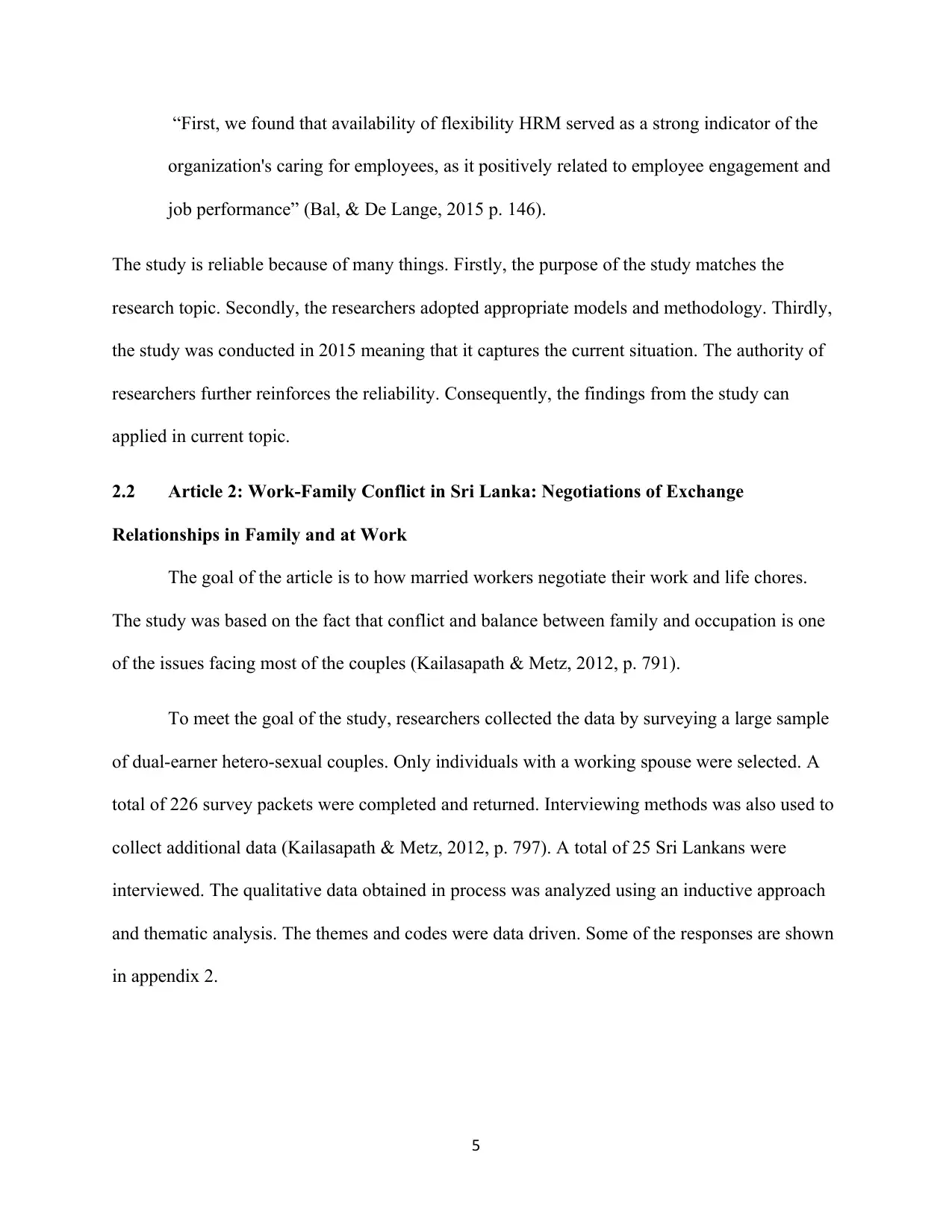
“First, we found that availability of flexibility HRM served as a strong indicator of the
organization's caring for employees, as it positively related to employee engagement and
job performance” (Bal, & De Lange, 2015 p. 146).
The study is reliable because of many things. Firstly, the purpose of the study matches the
research topic. Secondly, the researchers adopted appropriate models and methodology. Thirdly,
the study was conducted in 2015 meaning that it captures the current situation. The authority of
researchers further reinforces the reliability. Consequently, the findings from the study can
applied in current topic.
2.2 Article 2: Work-Family Conflict in Sri Lanka: Negotiations of Exchange
Relationships in Family and at Work
The goal of the article is to how married workers negotiate their work and life chores.
The study was based on the fact that conflict and balance between family and occupation is one
of the issues facing most of the couples (Kailasapath & Metz, 2012, p. 791).
To meet the goal of the study, researchers collected the data by surveying a large sample
of dual-earner hetero-sexual couples. Only individuals with a working spouse were selected. A
total of 226 survey packets were completed and returned. Interviewing methods was also used to
collect additional data (Kailasapath & Metz, 2012, p. 797). A total of 25 Sri Lankans were
interviewed. The qualitative data obtained in process was analyzed using an inductive approach
and thematic analysis. The themes and codes were data driven. Some of the responses are shown
in appendix 2.
5
organization's caring for employees, as it positively related to employee engagement and
job performance” (Bal, & De Lange, 2015 p. 146).
The study is reliable because of many things. Firstly, the purpose of the study matches the
research topic. Secondly, the researchers adopted appropriate models and methodology. Thirdly,
the study was conducted in 2015 meaning that it captures the current situation. The authority of
researchers further reinforces the reliability. Consequently, the findings from the study can
applied in current topic.
2.2 Article 2: Work-Family Conflict in Sri Lanka: Negotiations of Exchange
Relationships in Family and at Work
The goal of the article is to how married workers negotiate their work and life chores.
The study was based on the fact that conflict and balance between family and occupation is one
of the issues facing most of the couples (Kailasapath & Metz, 2012, p. 791).
To meet the goal of the study, researchers collected the data by surveying a large sample
of dual-earner hetero-sexual couples. Only individuals with a working spouse were selected. A
total of 226 survey packets were completed and returned. Interviewing methods was also used to
collect additional data (Kailasapath & Metz, 2012, p. 797). A total of 25 Sri Lankans were
interviewed. The qualitative data obtained in process was analyzed using an inductive approach
and thematic analysis. The themes and codes were data driven. Some of the responses are shown
in appendix 2.
5
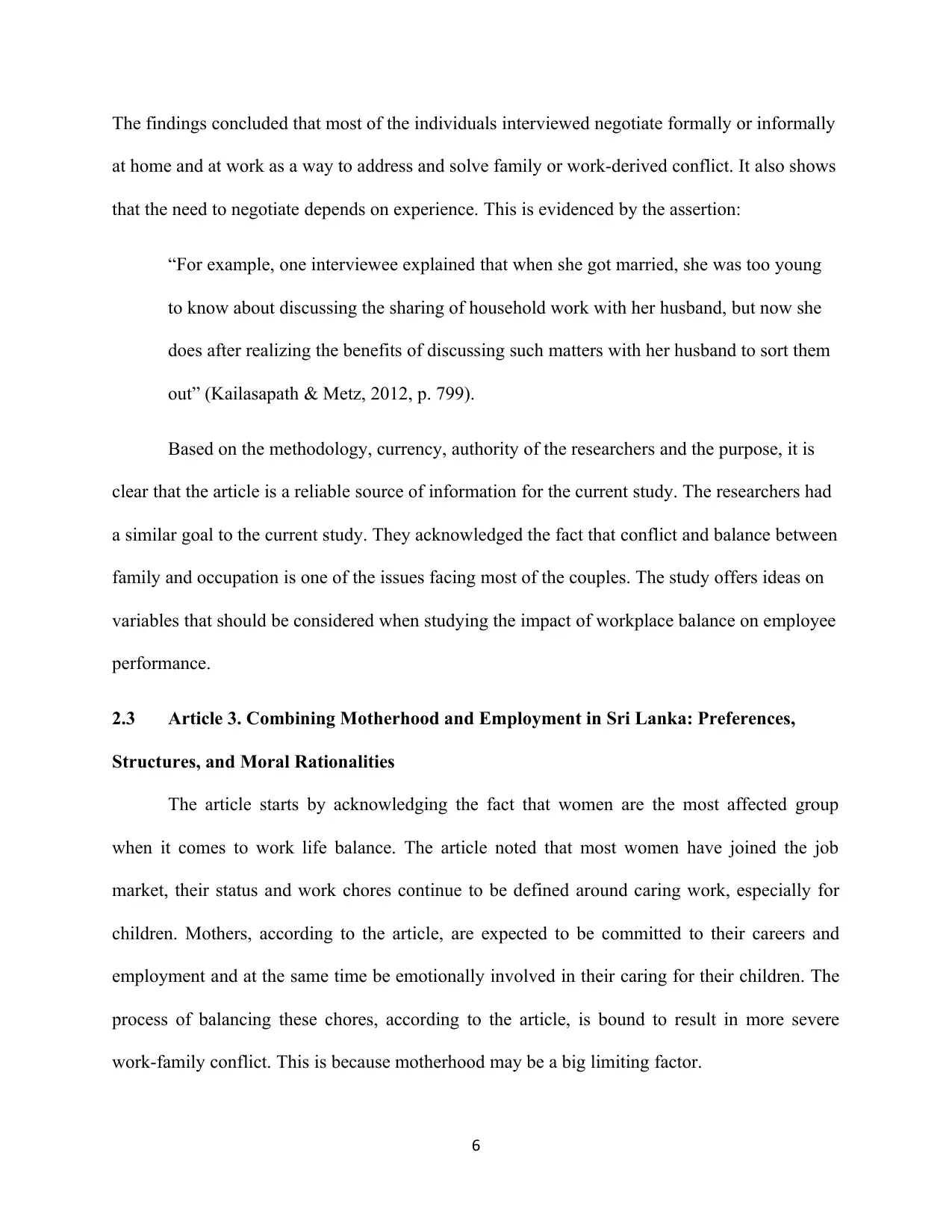
The findings concluded that most of the individuals interviewed negotiate formally or informally
at home and at work as a way to address and solve family or work-derived conflict. It also shows
that the need to negotiate depends on experience. This is evidenced by the assertion:
“For example, one interviewee explained that when she got married, she was too young
to know about discussing the sharing of household work with her husband, but now she
does after realizing the benefits of discussing such matters with her husband to sort them
out” (Kailasapath & Metz, 2012, p. 799).
Based on the methodology, currency, authority of the researchers and the purpose, it is
clear that the article is a reliable source of information for the current study. The researchers had
a similar goal to the current study. They acknowledged the fact that conflict and balance between
family and occupation is one of the issues facing most of the couples. The study offers ideas on
variables that should be considered when studying the impact of workplace balance on employee
performance.
2.3 Article 3. Combining Motherhood and Employment in Sri Lanka: Preferences,
Structures, and Moral Rationalities
The article starts by acknowledging the fact that women are the most affected group
when it comes to work life balance. The article noted that most women have joined the job
market, their status and work chores continue to be defined around caring work, especially for
children. Mothers, according to the article, are expected to be committed to their careers and
employment and at the same time be emotionally involved in their caring for their children. The
process of balancing these chores, according to the article, is bound to result in more severe
work-family conflict. This is because motherhood may be a big limiting factor.
6
at home and at work as a way to address and solve family or work-derived conflict. It also shows
that the need to negotiate depends on experience. This is evidenced by the assertion:
“For example, one interviewee explained that when she got married, she was too young
to know about discussing the sharing of household work with her husband, but now she
does after realizing the benefits of discussing such matters with her husband to sort them
out” (Kailasapath & Metz, 2012, p. 799).
Based on the methodology, currency, authority of the researchers and the purpose, it is
clear that the article is a reliable source of information for the current study. The researchers had
a similar goal to the current study. They acknowledged the fact that conflict and balance between
family and occupation is one of the issues facing most of the couples. The study offers ideas on
variables that should be considered when studying the impact of workplace balance on employee
performance.
2.3 Article 3. Combining Motherhood and Employment in Sri Lanka: Preferences,
Structures, and Moral Rationalities
The article starts by acknowledging the fact that women are the most affected group
when it comes to work life balance. The article noted that most women have joined the job
market, their status and work chores continue to be defined around caring work, especially for
children. Mothers, according to the article, are expected to be committed to their careers and
employment and at the same time be emotionally involved in their caring for their children. The
process of balancing these chores, according to the article, is bound to result in more severe
work-family conflict. This is because motherhood may be a big limiting factor.
6
⊘ This is a preview!⊘
Do you want full access?
Subscribe today to unlock all pages.

Trusted by 1+ million students worldwide
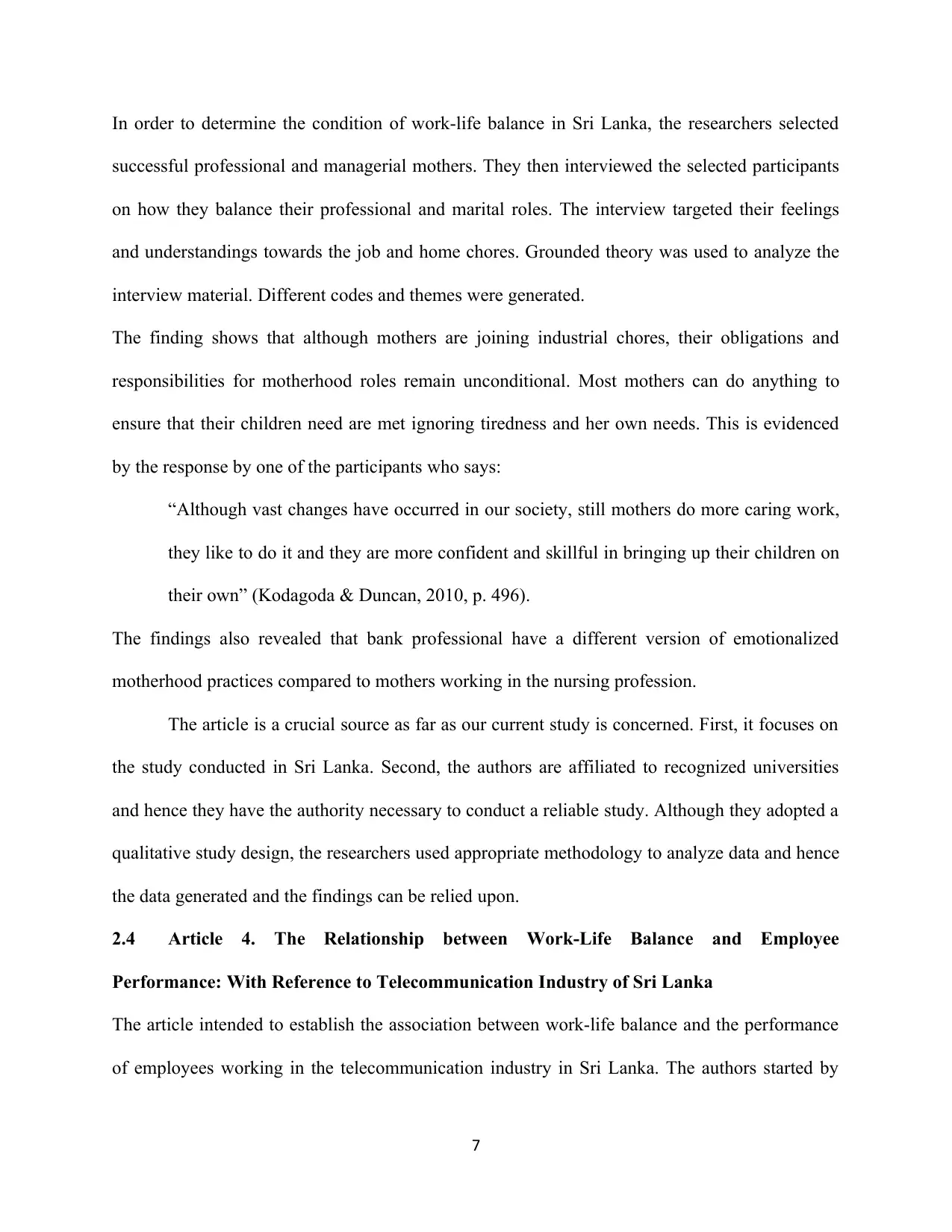
In order to determine the condition of work-life balance in Sri Lanka, the researchers selected
successful professional and managerial mothers. They then interviewed the selected participants
on how they balance their professional and marital roles. The interview targeted their feelings
and understandings towards the job and home chores. Grounded theory was used to analyze the
interview material. Different codes and themes were generated.
The finding shows that although mothers are joining industrial chores, their obligations and
responsibilities for motherhood roles remain unconditional. Most mothers can do anything to
ensure that their children need are met ignoring tiredness and her own needs. This is evidenced
by the response by one of the participants who says:
“Although vast changes have occurred in our society, still mothers do more caring work,
they like to do it and they are more confident and skillful in bringing up their children on
their own” (Kodagoda & Duncan, 2010, p. 496).
The findings also revealed that bank professional have a different version of emotionalized
motherhood practices compared to mothers working in the nursing profession.
The article is a crucial source as far as our current study is concerned. First, it focuses on
the study conducted in Sri Lanka. Second, the authors are affiliated to recognized universities
and hence they have the authority necessary to conduct a reliable study. Although they adopted a
qualitative study design, the researchers used appropriate methodology to analyze data and hence
the data generated and the findings can be relied upon.
2.4 Article 4. The Relationship between Work-Life Balance and Employee
Performance: With Reference to Telecommunication Industry of Sri Lanka
The article intended to establish the association between work-life balance and the performance
of employees working in the telecommunication industry in Sri Lanka. The authors started by
7
successful professional and managerial mothers. They then interviewed the selected participants
on how they balance their professional and marital roles. The interview targeted their feelings
and understandings towards the job and home chores. Grounded theory was used to analyze the
interview material. Different codes and themes were generated.
The finding shows that although mothers are joining industrial chores, their obligations and
responsibilities for motherhood roles remain unconditional. Most mothers can do anything to
ensure that their children need are met ignoring tiredness and her own needs. This is evidenced
by the response by one of the participants who says:
“Although vast changes have occurred in our society, still mothers do more caring work,
they like to do it and they are more confident and skillful in bringing up their children on
their own” (Kodagoda & Duncan, 2010, p. 496).
The findings also revealed that bank professional have a different version of emotionalized
motherhood practices compared to mothers working in the nursing profession.
The article is a crucial source as far as our current study is concerned. First, it focuses on
the study conducted in Sri Lanka. Second, the authors are affiliated to recognized universities
and hence they have the authority necessary to conduct a reliable study. Although they adopted a
qualitative study design, the researchers used appropriate methodology to analyze data and hence
the data generated and the findings can be relied upon.
2.4 Article 4. The Relationship between Work-Life Balance and Employee
Performance: With Reference to Telecommunication Industry of Sri Lanka
The article intended to establish the association between work-life balance and the performance
of employees working in the telecommunication industry in Sri Lanka. The authors started by
7
Paraphrase This Document
Need a fresh take? Get an instant paraphrase of this document with our AI Paraphraser
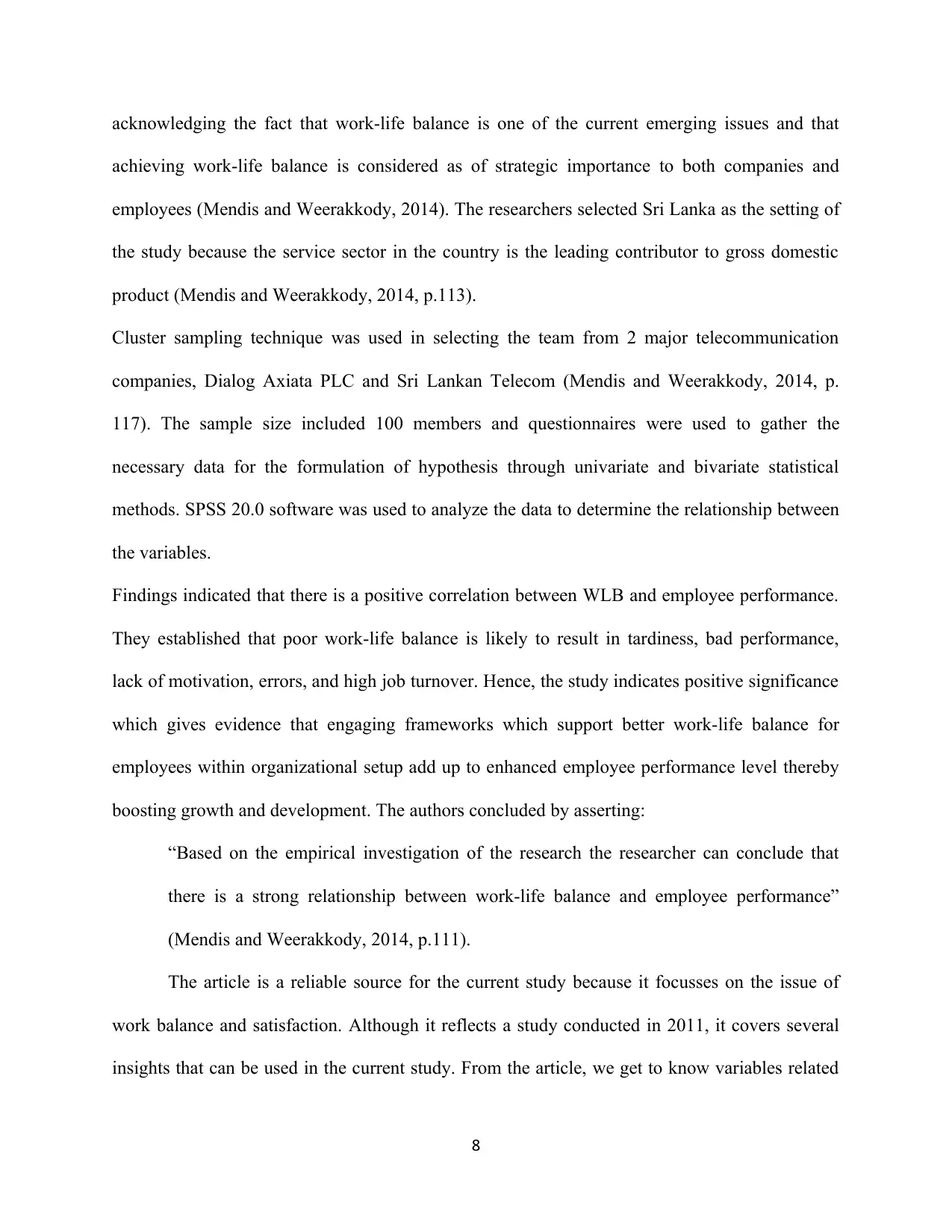
acknowledging the fact that work-life balance is one of the current emerging issues and that
achieving work-life balance is considered as of strategic importance to both companies and
employees (Mendis and Weerakkody, 2014). The researchers selected Sri Lanka as the setting of
the study because the service sector in the country is the leading contributor to gross domestic
product (Mendis and Weerakkody, 2014, p.113).
Cluster sampling technique was used in selecting the team from 2 major telecommunication
companies, Dialog Axiata PLC and Sri Lankan Telecom (Mendis and Weerakkody, 2014, p.
117). The sample size included 100 members and questionnaires were used to gather the
necessary data for the formulation of hypothesis through univariate and bivariate statistical
methods. SPSS 20.0 software was used to analyze the data to determine the relationship between
the variables.
Findings indicated that there is a positive correlation between WLB and employee performance.
They established that poor work-life balance is likely to result in tardiness, bad performance,
lack of motivation, errors, and high job turnover. Hence, the study indicates positive significance
which gives evidence that engaging frameworks which support better work-life balance for
employees within organizational setup add up to enhanced employee performance level thereby
boosting growth and development. The authors concluded by asserting:
“Based on the empirical investigation of the research the researcher can conclude that
there is a strong relationship between work-life balance and employee performance”
(Mendis and Weerakkody, 2014, p.111).
The article is a reliable source for the current study because it focusses on the issue of
work balance and satisfaction. Although it reflects a study conducted in 2011, it covers several
insights that can be used in the current study. From the article, we get to know variables related
8
achieving work-life balance is considered as of strategic importance to both companies and
employees (Mendis and Weerakkody, 2014). The researchers selected Sri Lanka as the setting of
the study because the service sector in the country is the leading contributor to gross domestic
product (Mendis and Weerakkody, 2014, p.113).
Cluster sampling technique was used in selecting the team from 2 major telecommunication
companies, Dialog Axiata PLC and Sri Lankan Telecom (Mendis and Weerakkody, 2014, p.
117). The sample size included 100 members and questionnaires were used to gather the
necessary data for the formulation of hypothesis through univariate and bivariate statistical
methods. SPSS 20.0 software was used to analyze the data to determine the relationship between
the variables.
Findings indicated that there is a positive correlation between WLB and employee performance.
They established that poor work-life balance is likely to result in tardiness, bad performance,
lack of motivation, errors, and high job turnover. Hence, the study indicates positive significance
which gives evidence that engaging frameworks which support better work-life balance for
employees within organizational setup add up to enhanced employee performance level thereby
boosting growth and development. The authors concluded by asserting:
“Based on the empirical investigation of the research the researcher can conclude that
there is a strong relationship between work-life balance and employee performance”
(Mendis and Weerakkody, 2014, p.111).
The article is a reliable source for the current study because it focusses on the issue of
work balance and satisfaction. Although it reflects a study conducted in 2011, it covers several
insights that can be used in the current study. From the article, we get to know variables related
8

to poor work-life balance such as tardiness, bad performance, lack of motivation, errors, and high
job turnover.
3.0 Conclusion
Evidently, the different sources reviewed clearly reveal that the work-life balance influences the
employee performance positively. Based on the four articles, it is clear that employees are
satisfied if they have the perception that human resource management would be flexible to allow
them to do their other roles because they will develop a feeling that the work environment is not
restrictive. Satisfaction, motivation and job performance is achieved when employees can
balance their occupational, personal, marital and parental roles and when there is satisfaction, the
performance is likely to improve. It is recognized that flexible policies with family and
supervisory styles consistent with work-family balance have a high incidence of satisfaction, as
well as in the reduction of conflicts caused by both roles.
4.0 Recommendations
Based on the findings, one of the recommendations is that companies should offer facilities for
parents. It can be deduced that parents, whether mothers or fathers, value belonging to a
company in which they are allowed to have a life-work balance in which they can enjoy time
with their children and be actively present in their lives. This means that a key factor in this
balance is to achieve a successful professional life without neglecting the lives of their children.
Some of the ways in which company can foster work-life balance are by offering options such as
special permits to attend school commitments, birthdays of the children, daycare within the
facilities, lactation rooms conditioned, longer periods of breastfeeding, among others.
9
job turnover.
3.0 Conclusion
Evidently, the different sources reviewed clearly reveal that the work-life balance influences the
employee performance positively. Based on the four articles, it is clear that employees are
satisfied if they have the perception that human resource management would be flexible to allow
them to do their other roles because they will develop a feeling that the work environment is not
restrictive. Satisfaction, motivation and job performance is achieved when employees can
balance their occupational, personal, marital and parental roles and when there is satisfaction, the
performance is likely to improve. It is recognized that flexible policies with family and
supervisory styles consistent with work-family balance have a high incidence of satisfaction, as
well as in the reduction of conflicts caused by both roles.
4.0 Recommendations
Based on the findings, one of the recommendations is that companies should offer facilities for
parents. It can be deduced that parents, whether mothers or fathers, value belonging to a
company in which they are allowed to have a life-work balance in which they can enjoy time
with their children and be actively present in their lives. This means that a key factor in this
balance is to achieve a successful professional life without neglecting the lives of their children.
Some of the ways in which company can foster work-life balance are by offering options such as
special permits to attend school commitments, birthdays of the children, daycare within the
facilities, lactation rooms conditioned, longer periods of breastfeeding, among others.
9
⊘ This is a preview!⊘
Do you want full access?
Subscribe today to unlock all pages.

Trusted by 1+ million students worldwide
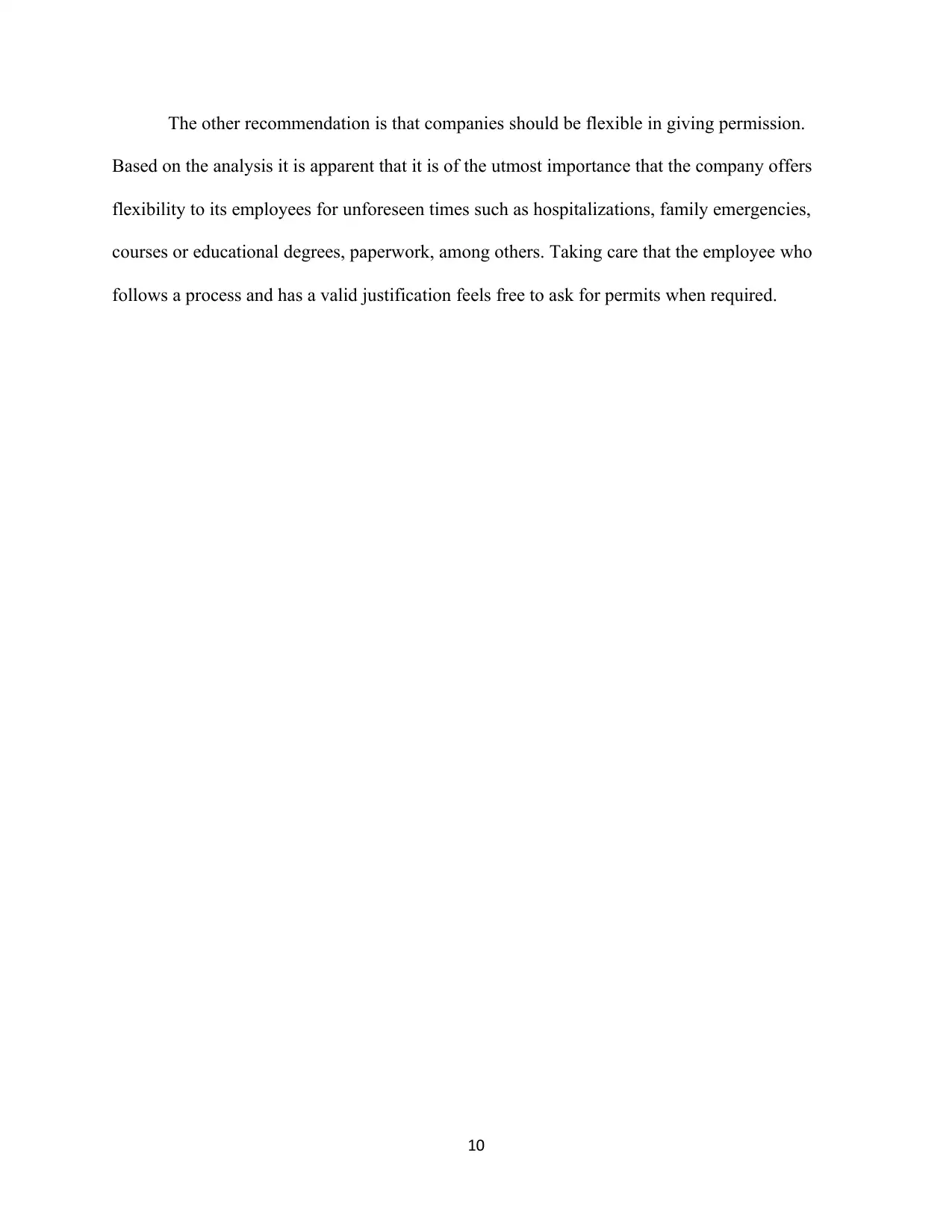
The other recommendation is that companies should be flexible in giving permission.
Based on the analysis it is apparent that it is of the utmost importance that the company offers
flexibility to its employees for unforeseen times such as hospitalizations, family emergencies,
courses or educational degrees, paperwork, among others. Taking care that the employee who
follows a process and has a valid justification feels free to ask for permits when required.
10
Based on the analysis it is apparent that it is of the utmost importance that the company offers
flexibility to its employees for unforeseen times such as hospitalizations, family emergencies,
courses or educational degrees, paperwork, among others. Taking care that the employee who
follows a process and has a valid justification feels free to ask for permits when required.
10
Paraphrase This Document
Need a fresh take? Get an instant paraphrase of this document with our AI Paraphraser

References
Bal, P.M. & De Lange, A.H. 2015, ‘From flexibility human resource management to employee
engagement and perceived job performance across the lifespan: A multisample study’, Journal
of Occupational & Organizational Psychology, vol. 88, no. 1, pp. 126–154
Dwi Putranti, H R 2018, ‘Organizational Commitment of Hospital Nurses: an Empirical Study
on Work-Life Balance and Burnout Management’, European Researcher, vol. 9, no. 3, pp. 235–
248
Haider, S, Jabeen, S & Ahmad, J 2018, ‘Moderated Mediation between Work-Life Balance and
Employee Job Performance: The Role of Psychological Wellbeing and Satisfaction with
Coworkers', Revista de Psicologia del Trabajo y de Las Organizaciones, vol. 34, no. 1, pp. 29–
37
Kailasapathy, P & Metz, I 2012, ‘Work-Family Conflict in Sri Lanka: Negotiations of Exchange
Relationships in Family and at Work’, Journal of Social Issues, vol. 68, no. 4, pp. 790–813
Kaliannan, M, Perumal, K & Dorasamy, M 2016, ‘Developing a Work-Life Balance Model
Towards Improving Job Satisfaction among Medical Doctors across Different Generations’,
Journal of Developing Areas, vol. 50, no. 5, pp. 343–351
Kazmi, A.B. & Singh, A.P. 2015, ‘Work-life balance, stress, and coping strategies as
determinants of job satisfaction among police personnel’, Indian Journal of Health & Wellbeing,
vol. 6, no. 12, pp. 1244–1247
Kodagoda, T & Duncan, S 2010, ‘Combining Motherhood and Employment in Sri Lanka:
Preferences, Structures and Moral Rationalities’, International Journal of Interdisciplinary
Social Sciences, vol. 5, no. 3, pp. 491–502
11
Bal, P.M. & De Lange, A.H. 2015, ‘From flexibility human resource management to employee
engagement and perceived job performance across the lifespan: A multisample study’, Journal
of Occupational & Organizational Psychology, vol. 88, no. 1, pp. 126–154
Dwi Putranti, H R 2018, ‘Organizational Commitment of Hospital Nurses: an Empirical Study
on Work-Life Balance and Burnout Management’, European Researcher, vol. 9, no. 3, pp. 235–
248
Haider, S, Jabeen, S & Ahmad, J 2018, ‘Moderated Mediation between Work-Life Balance and
Employee Job Performance: The Role of Psychological Wellbeing and Satisfaction with
Coworkers', Revista de Psicologia del Trabajo y de Las Organizaciones, vol. 34, no. 1, pp. 29–
37
Kailasapathy, P & Metz, I 2012, ‘Work-Family Conflict in Sri Lanka: Negotiations of Exchange
Relationships in Family and at Work’, Journal of Social Issues, vol. 68, no. 4, pp. 790–813
Kaliannan, M, Perumal, K & Dorasamy, M 2016, ‘Developing a Work-Life Balance Model
Towards Improving Job Satisfaction among Medical Doctors across Different Generations’,
Journal of Developing Areas, vol. 50, no. 5, pp. 343–351
Kazmi, A.B. & Singh, A.P. 2015, ‘Work-life balance, stress, and coping strategies as
determinants of job satisfaction among police personnel’, Indian Journal of Health & Wellbeing,
vol. 6, no. 12, pp. 1244–1247
Kodagoda, T & Duncan, S 2010, ‘Combining Motherhood and Employment in Sri Lanka:
Preferences, Structures and Moral Rationalities’, International Journal of Interdisciplinary
Social Sciences, vol. 5, no. 3, pp. 491–502
11
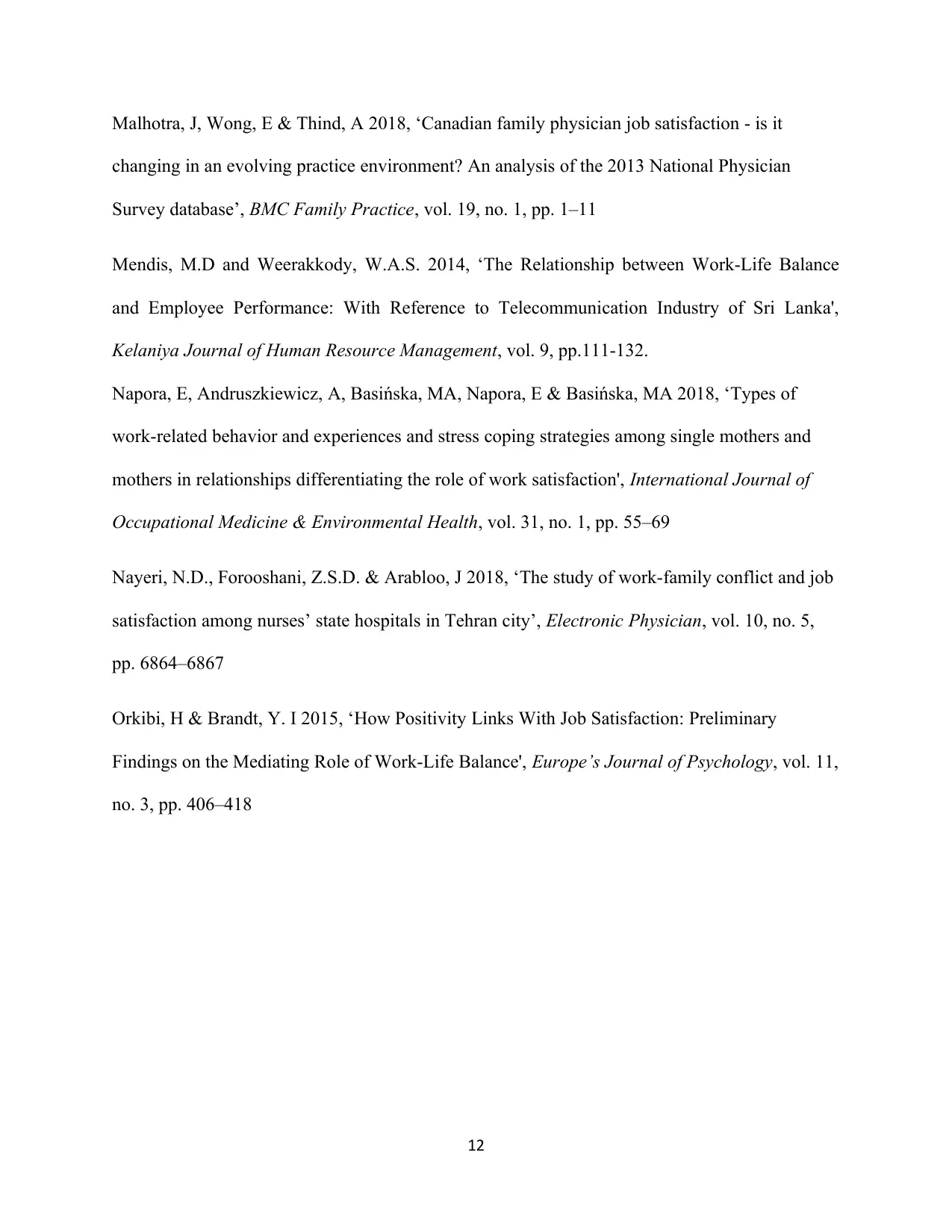
Malhotra, J, Wong, E & Thind, A 2018, ‘Canadian family physician job satisfaction - is it
changing in an evolving practice environment? An analysis of the 2013 National Physician
Survey database’, BMC Family Practice, vol. 19, no. 1, pp. 1–11
Mendis, M.D and Weerakkody, W.A.S. 2014, ‘The Relationship between Work-Life Balance
and Employee Performance: With Reference to Telecommunication Industry of Sri Lanka',
Kelaniya Journal of Human Resource Management, vol. 9, pp.111-132.
Napora, E, Andruszkiewicz, A, Basińska, MA, Napora, E & Basińska, MA 2018, ‘Types of
work-related behavior and experiences and stress coping strategies among single mothers and
mothers in relationships differentiating the role of work satisfaction', International Journal of
Occupational Medicine & Environmental Health, vol. 31, no. 1, pp. 55–69
Nayeri, N.D., Forooshani, Z.S.D. & Arabloo, J 2018, ‘The study of work-family conflict and job
satisfaction among nurses’ state hospitals in Tehran city’, Electronic Physician, vol. 10, no. 5,
pp. 6864–6867
Orkibi, H & Brandt, Y. I 2015, ‘How Positivity Links With Job Satisfaction: Preliminary
Findings on the Mediating Role of Work-Life Balance', Europe’s Journal of Psychology, vol. 11,
no. 3, pp. 406–418
12
changing in an evolving practice environment? An analysis of the 2013 National Physician
Survey database’, BMC Family Practice, vol. 19, no. 1, pp. 1–11
Mendis, M.D and Weerakkody, W.A.S. 2014, ‘The Relationship between Work-Life Balance
and Employee Performance: With Reference to Telecommunication Industry of Sri Lanka',
Kelaniya Journal of Human Resource Management, vol. 9, pp.111-132.
Napora, E, Andruszkiewicz, A, Basińska, MA, Napora, E & Basińska, MA 2018, ‘Types of
work-related behavior and experiences and stress coping strategies among single mothers and
mothers in relationships differentiating the role of work satisfaction', International Journal of
Occupational Medicine & Environmental Health, vol. 31, no. 1, pp. 55–69
Nayeri, N.D., Forooshani, Z.S.D. & Arabloo, J 2018, ‘The study of work-family conflict and job
satisfaction among nurses’ state hospitals in Tehran city’, Electronic Physician, vol. 10, no. 5,
pp. 6864–6867
Orkibi, H & Brandt, Y. I 2015, ‘How Positivity Links With Job Satisfaction: Preliminary
Findings on the Mediating Role of Work-Life Balance', Europe’s Journal of Psychology, vol. 11,
no. 3, pp. 406–418
12
⊘ This is a preview!⊘
Do you want full access?
Subscribe today to unlock all pages.

Trusted by 1+ million students worldwide
1 out of 14
Related Documents
Your All-in-One AI-Powered Toolkit for Academic Success.
+13062052269
info@desklib.com
Available 24*7 on WhatsApp / Email
![[object Object]](/_next/static/media/star-bottom.7253800d.svg)
Unlock your academic potential
Copyright © 2020–2025 A2Z Services. All Rights Reserved. Developed and managed by ZUCOL.




